[ad_1]
Competent marketers recognize the importance of smart SEO strategies. Such strategies are essential for growing a loyal audience, increasing site traffic, and accelerating conversion rates. What’s more, what it takes to optimize landing pages for top keywords—a central piece of SEO—has changed fundamentally. This has been true ever since Google implemented its RankBrain algorithm. Therefore, it’s becoming increasingly important to develop new SEO strategies for better SERP rankings.
SEO, by the way, stands for “search engine optimization.” And SERP stands for “search engine results page.” We’ll get into more details about both in this article.
What Is the RankBrain Algorithm?
RankBrain is Google’s machine-learning artificial intelligence (AI) algorithm. Google uses it alongside its other human-engineered algorithms to sort search results.
The RankBrain algorithm looks at SERP’s for various keywords. Then it tweaks the importance of such ranking signals as backlinks, domain authority, content length, and so on. These tweaks result in different SERP’s. The RankBrain algorithm then analyzes how searchers interact with the new results. If they find the new SERP displays better content, RankBrain keeps the changes. If not, it reverts back to the old algorithm.
The point of these exercises is to provide searchers with more useful results.
When RankBrain makes tweaks to SERP’s, certain pages will get more attention. When that happens, those pages rise in the rankings. If searchers find any particular page not to be useful, RankBrain will replace that page on the SERP with a different page. The RankBrain algorithm will then analyze how that page performs.
How Does RankBrain Determine If Searchers Like the New Results Better?
Here are a few of the ways in which the RankBrain algorithm determines if searchers like the new results better:
- Organic click-through rate
- Time on page
- Bounce rate
Before implementing the RankBrain algorithm, Google displayed SERP’s simply by matching words in a search query to words on an individual page. With RankBrain, the AI attempts to learn what the words mean together. In other words, the RankBrain algorithm tries to understand the intent of the keywords, including the context. This results in more fruitful search results for the searcher.
How Does the RankBrain Algorithm Affect Optimizing Keywords on Landing Pages?
Before RankBrain, the most commonly agreed-upon and effective SEO keyword targeting strategy was to build many different landing pages. Each landing page was then optimized for a number of different long-tail keywords.
For example, an SEO strategy for optimizing a travel blog would be to create one landing page targeting “best hiking routes in Hawaii.” Another landing page would target “best hiking trails in Hawaii.” After that, Google would rank each of the landing pages for their individual long-tail keywords.
However, since Google implemented RankBrain, the Google algorithm now understands that these long-tail keywords are essentially the same. The RankBrain algorithm therefore delivers almost identical SERP’s for both phrases. This makes it ineffective to optimize around long-tail keyword phrases anymore.

New Strategies: Optimizing for the RankBrain Algorithm
In short, instead of optimizing landing pages for long-tail keywords, SEO strategies should target mid-tail keywords. Below is a screenshot from Ahrefs showing keyword difficulty, cost per click (CPC), search volume, and other metrics for six keyword phrases related to “New Zealand Hiking.”

As expected, the shorter keyword phrases have significantly higher search volume than their long-tail counterparts. In the past, these mid-tail keywords would be more difficult to effectively target. In other words, it would be more difficult to break into the top three search results by using them. However, with the introduction of the RankBrain algorithm, these mid-tails present a new opportunity. That is, they allow SEO’s to target more generic, mid-tail keyword phrases. Now, when they do, the Google algorithm understands their intent.
How Do I Decide the Best Mid-Tail Keyword to Target?
There are myriad SEO tools and metrics that you can use to analyze keyword viability. To name only a few, there are SEMRush, Google Keyword Planner, Ahrefs, and Brightedge.
However, one brilliant strategy involves something much more basic. That is, conduct some simple Google searches yourself with a single keyword phrase. Then compare broad-match results, exact-match results, and the total number of both for that phrase. It’s also useful to compare the domain ratings for first-page SERP’s during the comparison process. This will give you an idea of how difficult it will be to rank highly.
For example, using the “New Zealand Hiking” search metrics above, you’ll notice that the two most searched phrases are “New Zealand Hiking” and “Hiking in New Zealand.” These two phrases average 600 and 450 monthly searches respectively. Compare this with the 150 or fewer average monthly searches for the remaining keyword phrases.
How to Use This Deceptively Simple Method
Therefore, the first step in deciding which keyword phrase to target is to perform a Google search using one of the phrases you are considering. Then perform another with the same keyword phrase in quotes. Finally, compare the number of broad match and exact match search results.

The first thing you might notice is that the keyword phrase “New Zealand Hiking” has significantly fewer search results in both broad and exact match instances. This is despite its having an average of 150 more searches a month than “Hiking in New Zealand” (600 vs. 450).
On the surface, this simple comparison shows that there is more search volume and less competition and saturation in the “New Zealand Hiking” SERP. This points to this particular keyword phrase as the better choice. However, before we draw any final conclusions, it’s important to analyze the sites ranking on the first page for each of the keyword phrases. This will allow us to determine what their domain authorities are, and how our site stacks up in this space.
Here’s an Example
Below is a screenshot from Ahrefs showing the first page SERP’s for both “New Zealand Hiking” and “Hiking in New Zealand.”
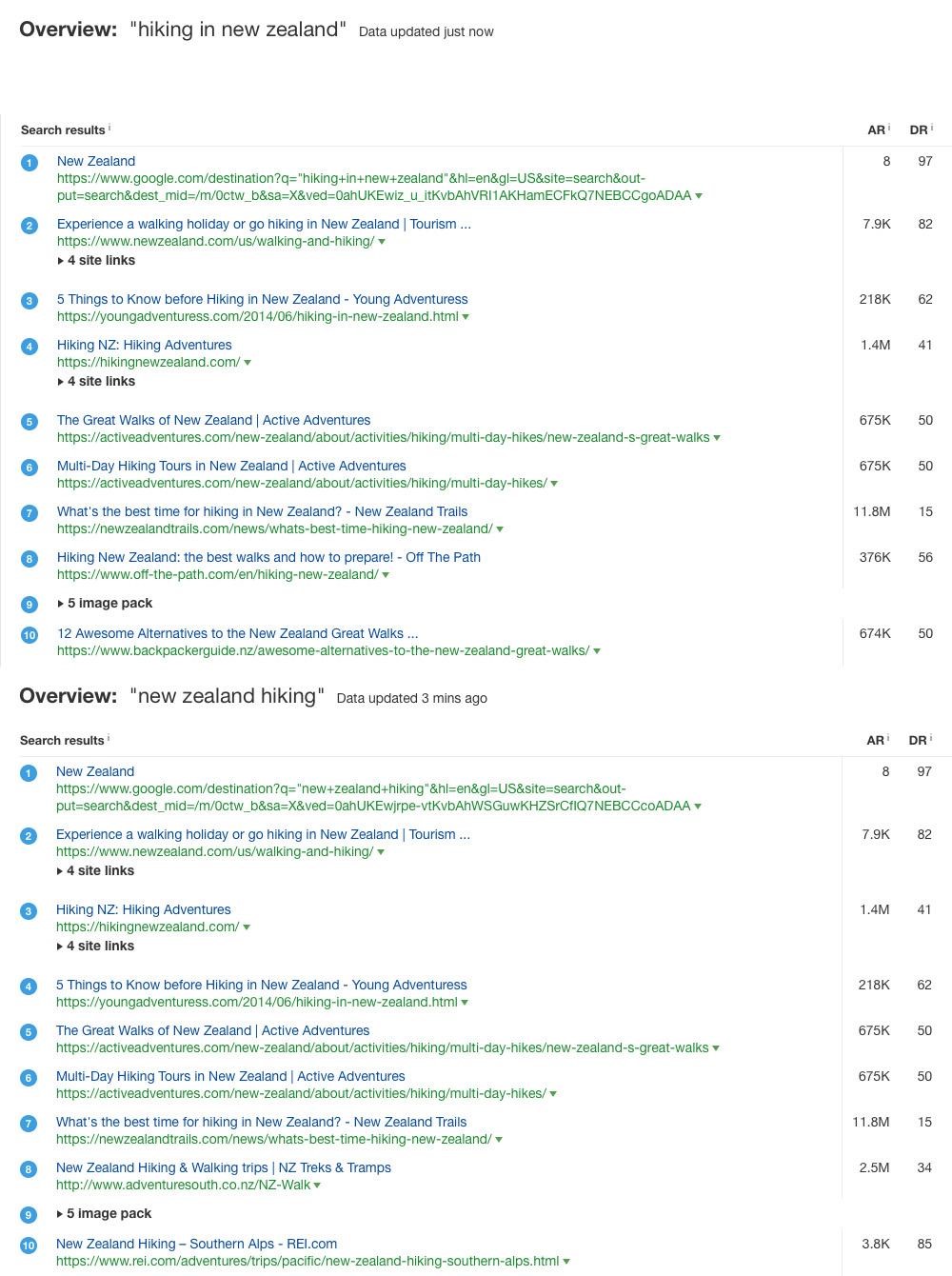
In this instance, and likely because of the RankBrain algorithm, the SERP’s are nearly identical, with a few exceptions. Because of these similarities, you could choose a mid-tail keyword based on overall number of results displayed, contrasted against average monthly search volume. In this example, that proper choice would be “New Zealand Hiking.”
RELATED ARTICLE: HOW TO CREATE A WEBSITE DESIGN THAT EMPOWERS YOUR SEO EFFORTS
Optimizing Landing Pages to Generate Maximum SERP Positions Will Increase Traffic and Give You More Conversions
Well targeted keywords is an important factor in raising your SERP rankings, increasing site traffic, and having more conversions. However, without well optimized landing pages much of your hard work can go unnoticed. In that case, growth can be slow.
However, Google has provided SEO marketers with tools that help the web spiders better understand what the on-page content is all about. First and foremost among these tools is schema markup.
What Is Schema Markup?
Schema markup, also known as structured data markup, is a vocabulary that you can add to a wide variety of encodings. These include RDFa, JSON-LD, Microdata, and others. Every page on your site that can have schema should have one.
Depending on the type of page you wish to mark up, whether it be product pages, informational content, blog posts, or anything else, Schema.org provides a selection of items and associated properties that you can add to the HTML/CSS of your page. These items will help Google’s web crawlers better understand the intent and purpose of your content.
The better Google understands your content, the more likely your content will rank higher. Below, you can see an example of schema markup for a blog post from Instasize entitled “5 Ways to Utilize Instagram Stories to Boost Sales.” Notice how the markup code is nested above the <h1>, between the <div> and <script> tags.
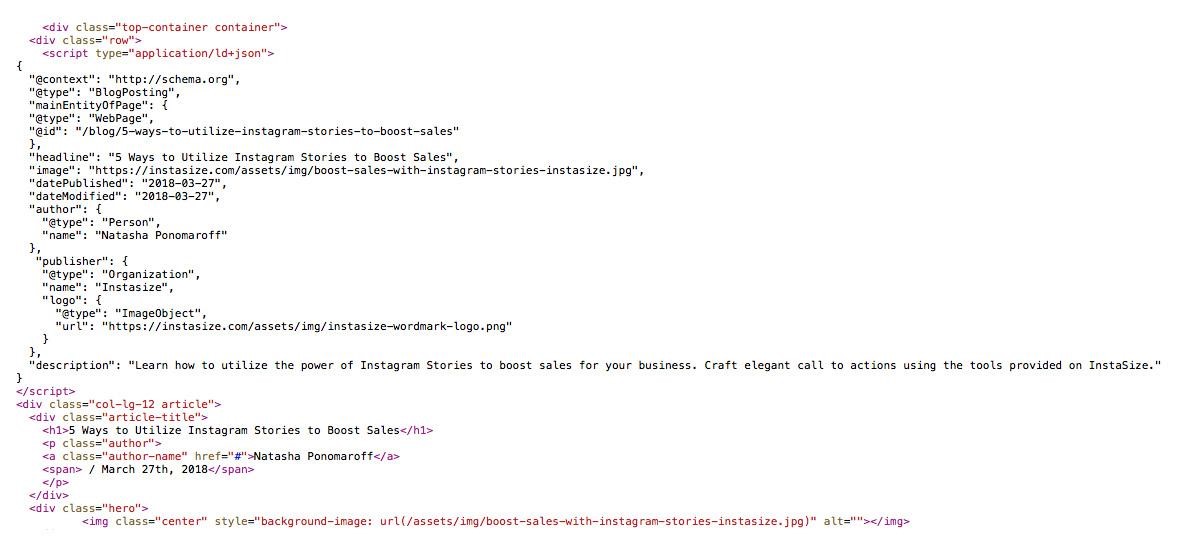
A Detailed Explanation
This is best explained by the Moz blog in a post entitled “Unlocking Hidden Gems Within Schema.org”:
“When you first enter a Schema.org item type’s page, notice that every page has the same layout, starting with the item type name, the canonical reference URL (currently the HTTP version*), where the markup lives within the Schema.org hierarchy, and that item type’s usage on the web.
“An item type is a piece of Schema.org’s vocabulary of data used to annotate and structure elements on a web page. You can think about it as what you’re marking up.
“At the highest level of most Schema.org item types is Thing (alternatively, we’d be looking at DataType). This intuitively makes sense because almost everything is, at its highest level of abstraction, a Thing. The item type Thing has multiple children, all of which assume Thing’s properties in a cascading hierarchical fashion (i.e., a Product is a Thing. Both can have names, descriptions, and images).”
You can find a visual representation of schema’s hierarchy in the image below.
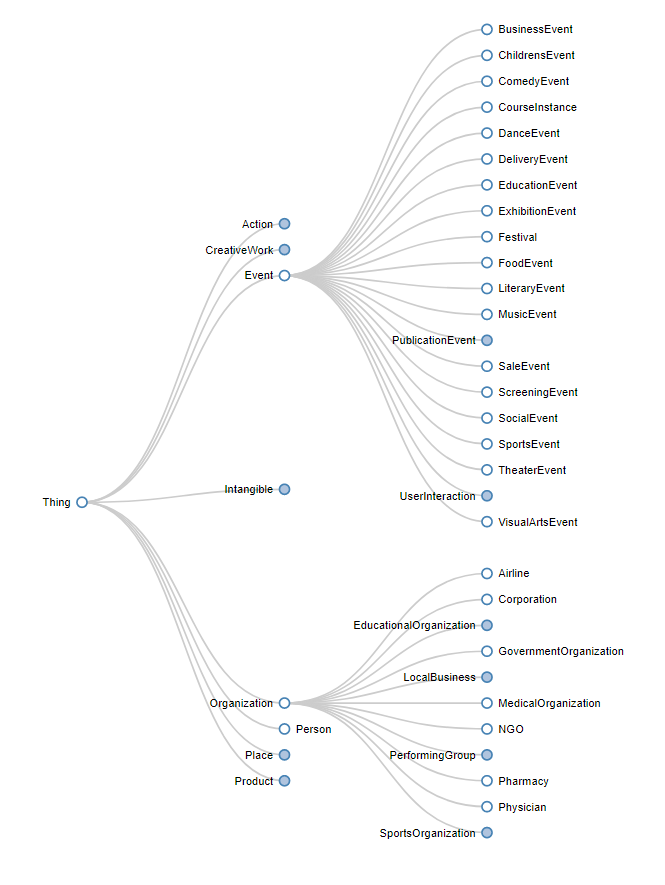
Image courtesy of technicalseo.com
One of the easiest starting points for acquainting yourself with schema is to use the schema generator from Merkle. Using the Merkle schema generator is fairly simple. Just choose a type of markup from the drop-down menu.
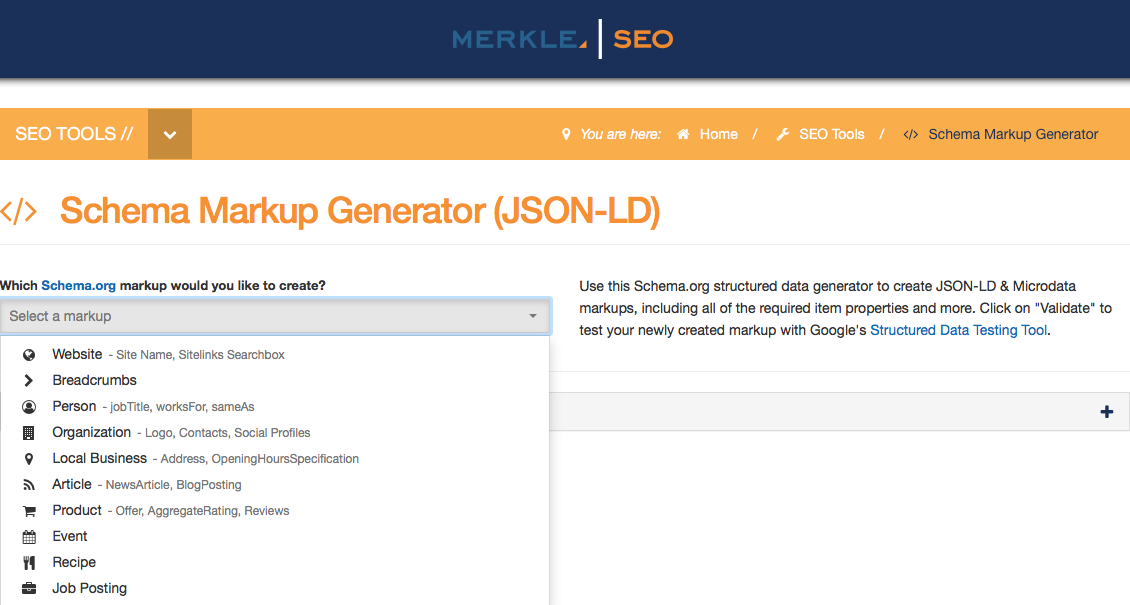
Once you’ve chosen a markup type, you’ll be prompted to fill in various fields. Then the schema markup code will be automatically generated in the right field.
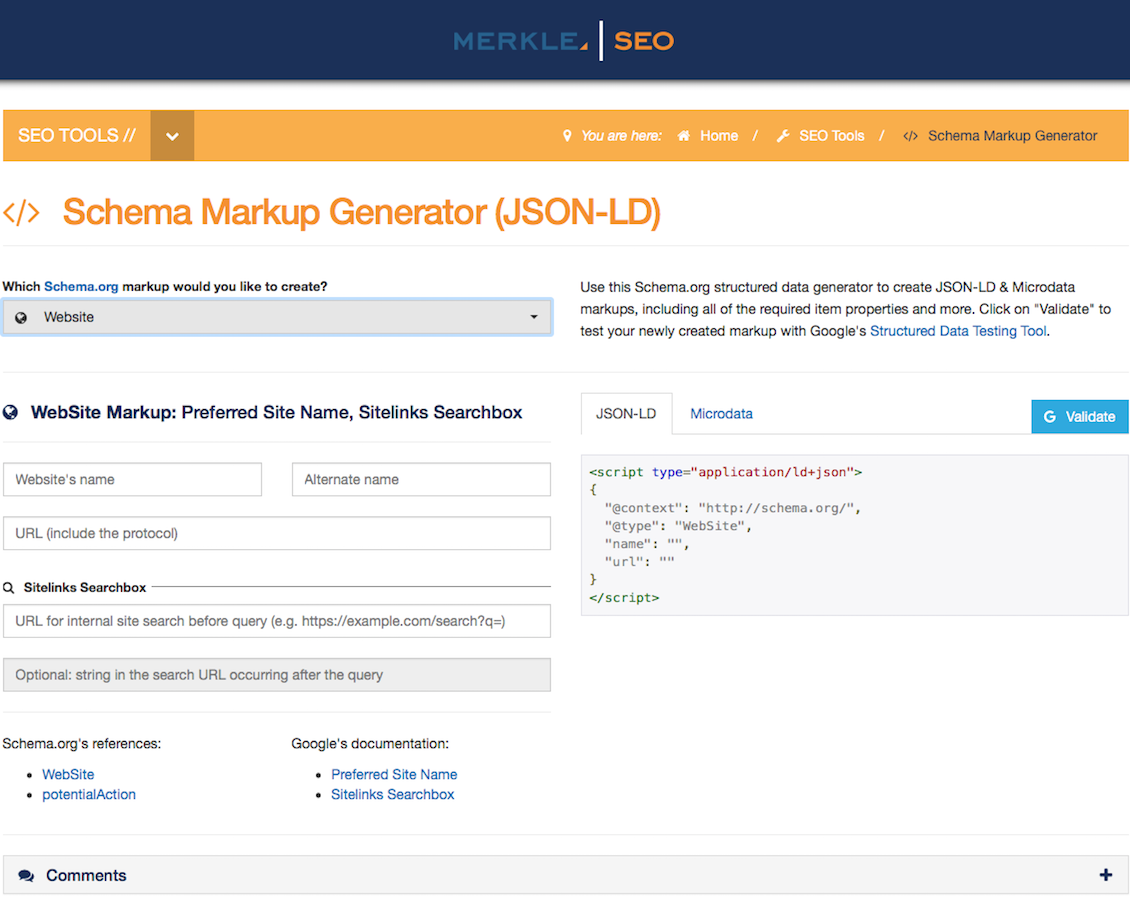
Once you’ve filled in all the necessary fields, copy and paste the auto-generated schema into Google’s Structured Data Testing Tool. Make sure the code is functioning properly, then paste the code above or below the <body> tags of your page.

Targeting Featured Snippets to Rank Above First Position for Top Keywords
A featured snippet is a box that appears above all results for various question-and-answer based queries. Below is a screenshot of a search for, “Are dogs colorblind?” Here you can see a short paragraph with an answer pulled from one of the pages listed in the SERP.

(Note: Featured snippets only pull from the top 10 results of any given SERP. Therefore, you must already rank 1-10 for a specific keyword phrase to be eligible for a feature placement.)
With more and more SERP’s for similar search queries returning similar results because of the RankBrain algorithm, the chances of securing a featured snippet across multiple similar queries has greatly increased. This could create a massive traffic and conversion boon for sites with savvy SEO practitioners who are willing to invest time in targeting featured snippets.
How to Target Featured Snippet Opportunities
Featured snippets appear for a wide array of search queries. What’s more, they can increase page visibility, conversion rates, and traffic to your site. So how do you go about targeting these opportunities?
Most of the time, though not all, featured snippets appear as an answer to question-based queries. Let’s say you run a food blog and have posted an article about making spaghetti and meatballs. Further, your targeted keyword phrase is “spaghetti and meatballs.” Of course, the quality and thoroughness of your content is a major factor in determining if Google will pull your information into a featured snippet. However, how you organize and label your content is also important.
Use Headings with How-to Formats
Therefore, instead of using simple headings, try writing some of your headings in how-to format. For example, you could make your first H2 something like, “How to Make Spaghetti and Meatballs.” As an example of this, notice the screenshot below showing the SERP’s for two similar queries. The first search for “spaghetti and meatballs” returns without a snippet. However, “how to make spaghetti and meatballs” returns with a snippet pulled from a Youtube video.
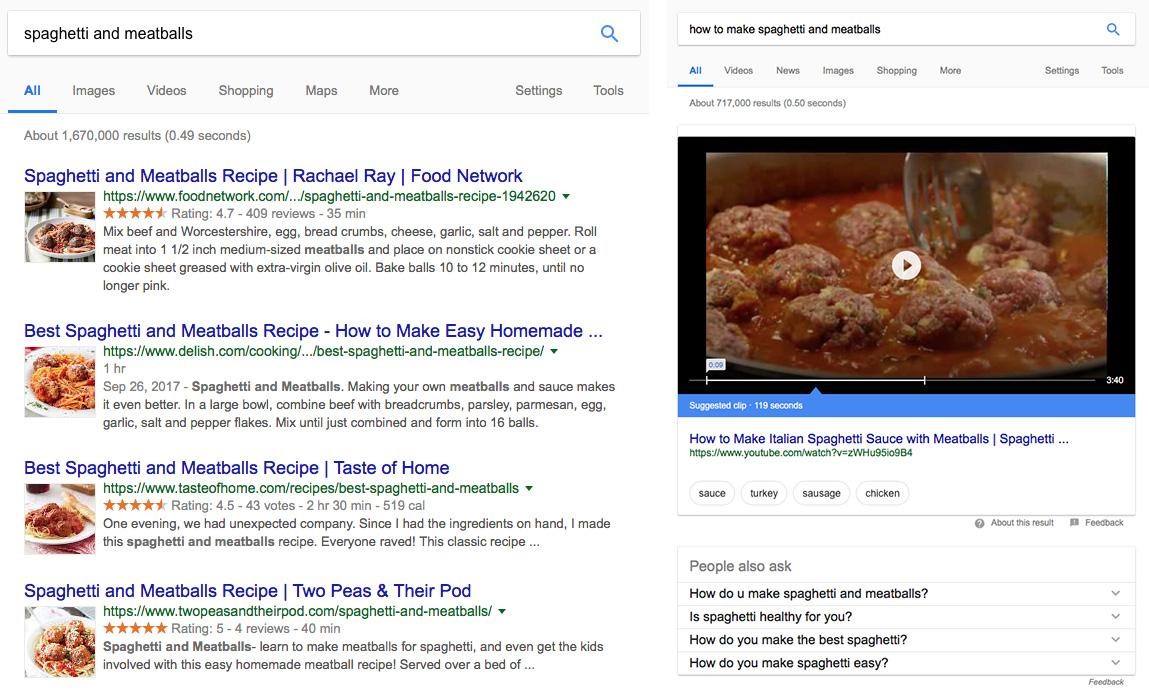
One of the best ways to generate this type of headline is with answerthepublic.com.
Answer the Public describes itself as a “free visual keyword research and content ideas” tool. It can provide you with a wide range of useful data. For example, entering a simple keyword phrase into the search bar returns multiple lists of related question-based, preposition-based, and comparison-based search queries. Check out the example below using the keyword phrase “spaghetti and meatballs.”
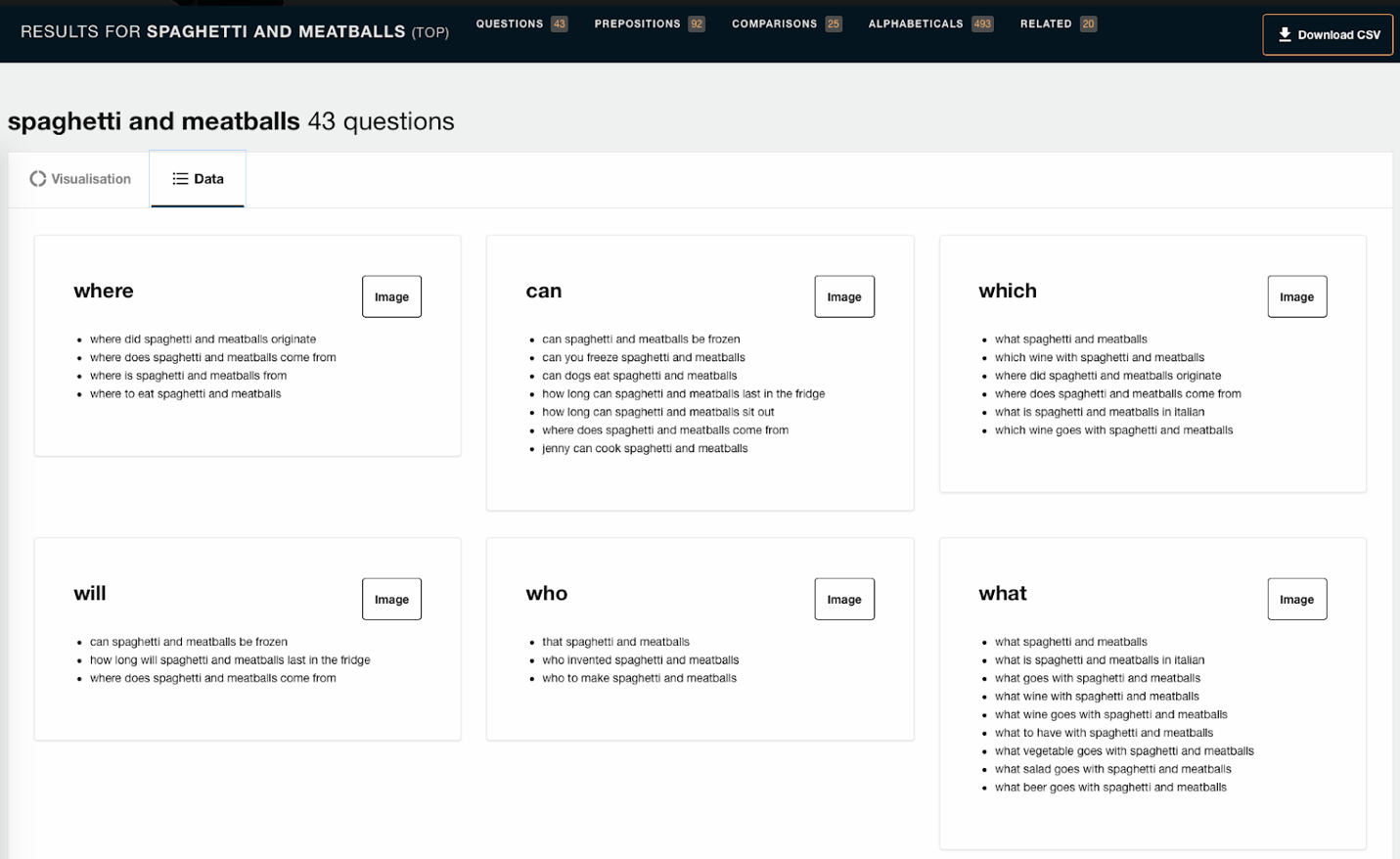
You can use the results from this page to brainstorm a question-and-answer style headline. This can greatly increase the chances of your content being pulled into a featured snippet.
Other factors Google seems to like when pulling snippets is content built in lists or html tables. What’s more, your content needs to be free of grammatical errors.
Snackable Takeaways: Creating Traffic and Conversion Rate Growth with Actionable SEO Strategies
- The RankBrain algorithm has changed the way we look at keyword targeting. In short, it forces us to reorient the focus from long-tail keywords to mid-tail keywords.
- As the RankBrain AI continues to learn and further understand the meaning of keyword phrases and their context, semantic variation of similar queries will matter less and less. That’s because they largely return identical results. This causes SEO marketers to shift focus. That is, SEO strategies should now primarily be about ensuring that everything you publish is evergreen and of only the highest quality. In other words, chasing keywords will no longer work.
- Schema markup is relatively simple. What’s more, in today’s SEO climate it is an absolute must if you want to remain competitive for your top keywords.
- With more and more SERP’s for similar search queries returning similar results because of the RankBrain algorithm, you have a much better chance of securing a featured snippet across multiple similar queries.
- Targeting featured snippets by optimizing your on-page content can propel your top landing pages to the very top of Google SERP’s. This greatly increases your pages’ overall visibility, site traffic, and conversion rate.
About the Author
Sam Schuler is an SEO strategist at Instasize.
[ad_2]
Source link
Leave a Reply